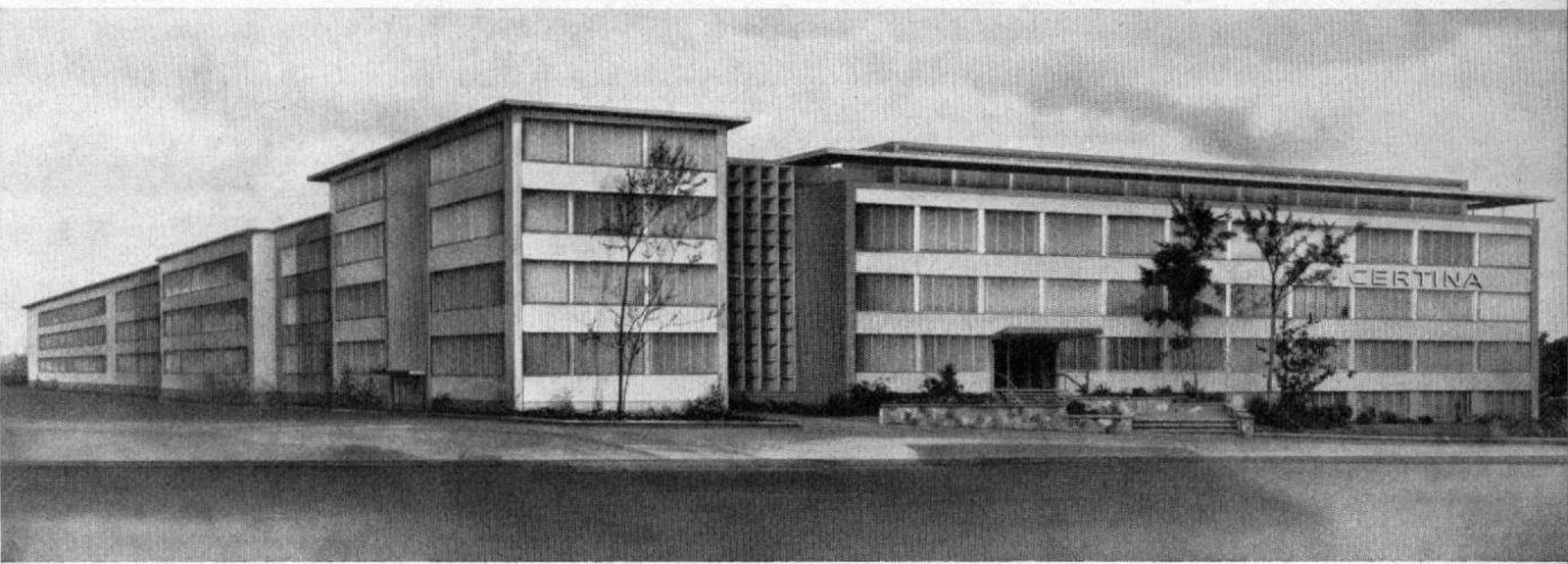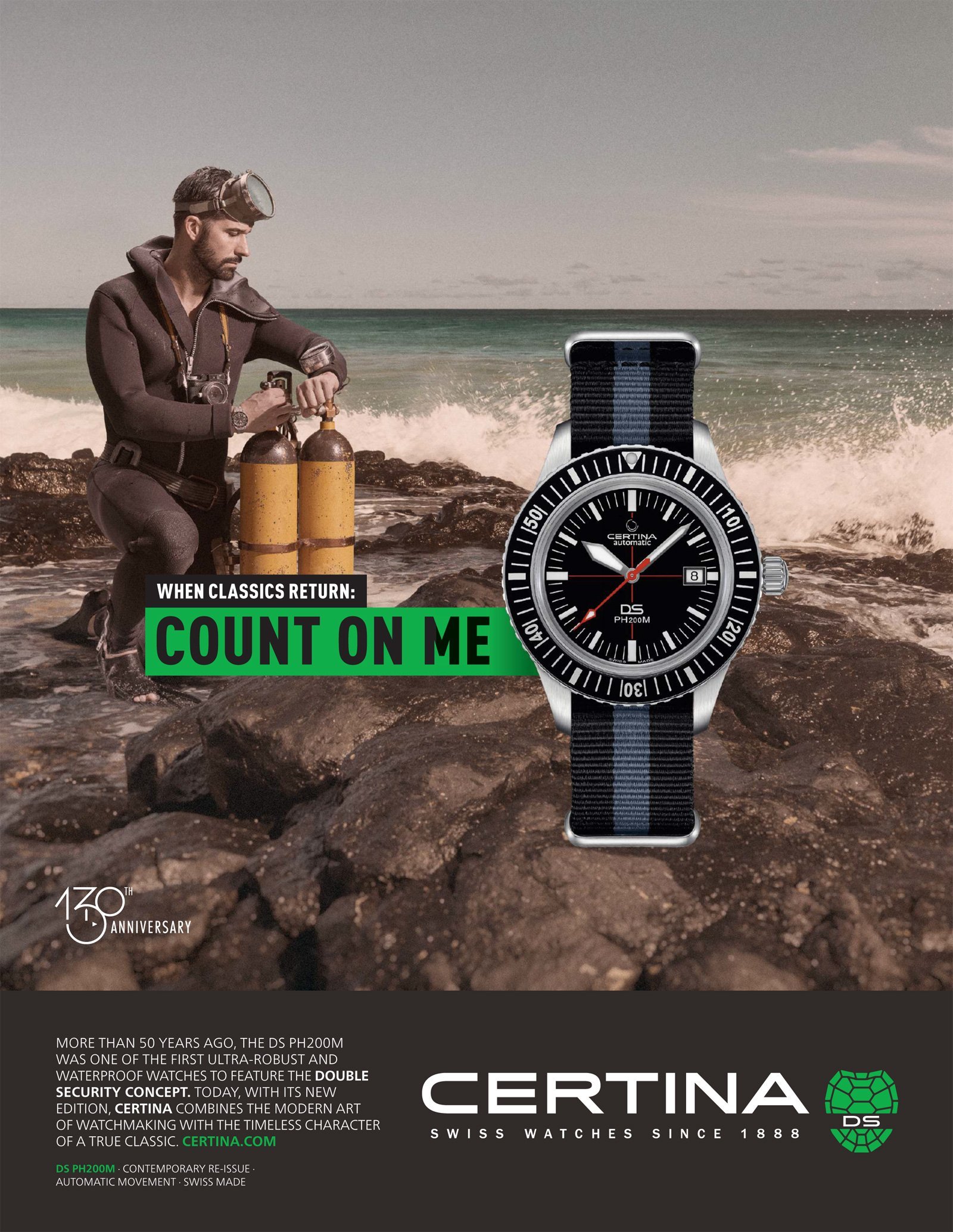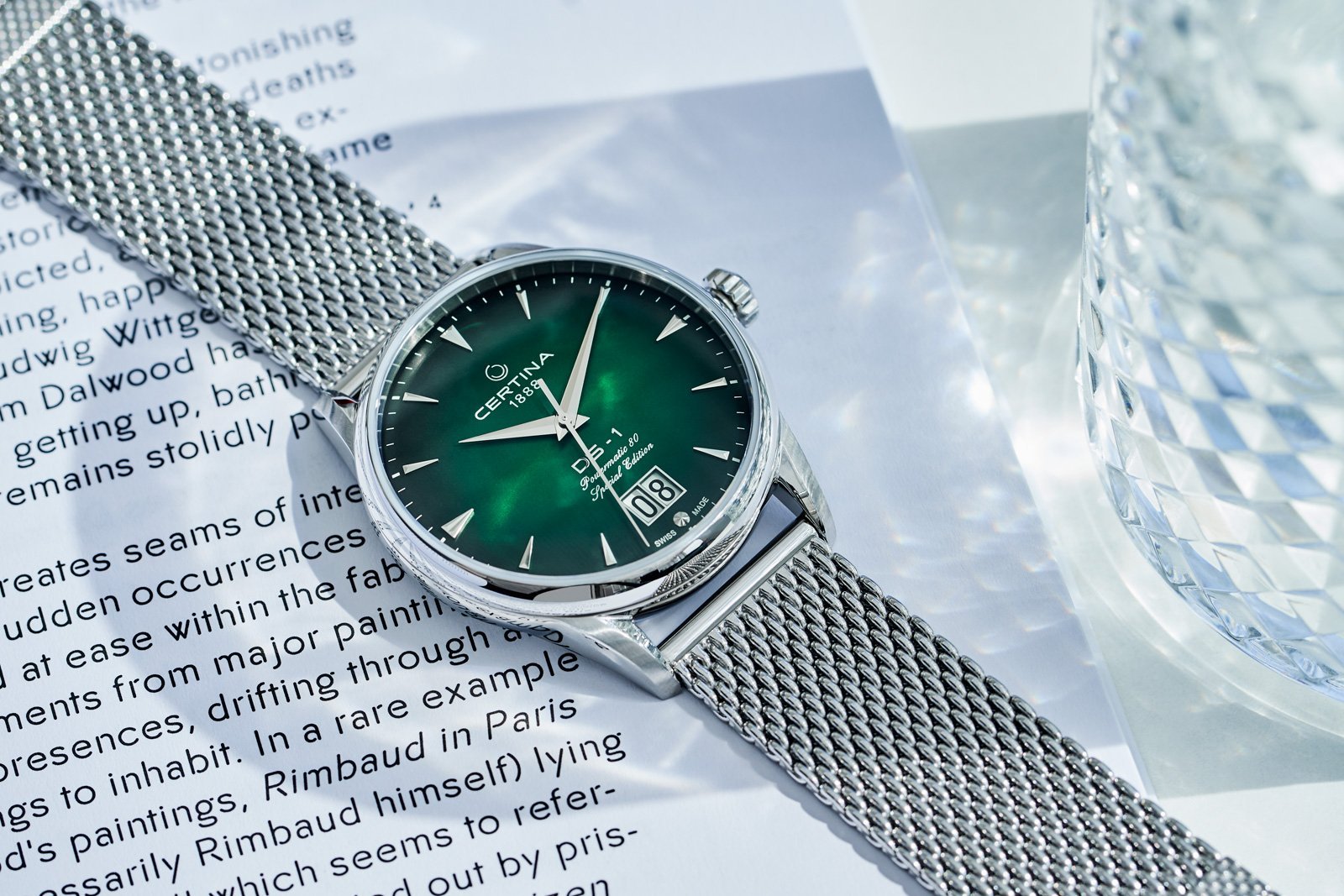he Certina brand was officially registered exactly 80 years ago, in 1939. And the Certina DS was launched 60 years ago, in 1959. And so 2019 marks a dual anniversary, even if the origins of the brand go back much farther: to 1888, when brothers Adolf and Alfred Kurth set up their watchmaking workshop in Granges, not far from Bienne, at first with three employees.
The company grows fast, thrives, recruits, but only in 1906 do the Kurth brothers launch a brand name for their products: Grana, the Latin form of Granges. In the early 1930s, their successors, Erwin and Hans Kurth, begin using another name: Certina, a name derived from the Latin certus meaning “worthy of confidence”. Easy to pronounce in every language, the name catches on and gradually ousts Grana to become the sole brand in 1949 (70 years ago – yet another anniversary). But back to 1959, the launch year of the Certina DS!

1959, A GREAT YEAR FOR CERTINA
Seventy years after its creation the manufacture, now bearing the sole name of Certina, inaugurates two new buildings in Granges. Totalling 10,000 m3, they house the administration, engineering department, research laboratory and, in the upper storeys, brand-new assembly and adjustment workshops vaunted for their modernity (air-conditioning, dust filters, automation, etc.). “Scientifically organised labour” writes one article of the time, pointing out in passing one special aspect: “The workshops are equipped with loudspeakers broadcasting appropriate music at certain times of the day, a measure which has proved to have had a positive effect on production.”
-

- The modernist entrance hall of the Certina factory in 1959
But this year of 1959 will also go down in the annals thanks to one striking watch: the Certina DS, the heritage of which will endure – and considerably develop over the decades right up to the present day. But what is the Certina DS?
A “FLOATING” MOVEMENT
The original idea, launched in the early 1950s under the leadership of engineer Philipp Kurth, is to attain the greatest possible robustness combined with the highest water-resistance. To achieve this, the engineers at Certina (inspired, who knows, by some “water music”) explored numerous avenues of research, ultimately developing the “floating” movement.

Explained briefly, this is a movement encased entirely in an elastic shock absorber ring resembling an O-ring gasket, which absorbs the kinetic energy released by vibration and shocks. In addition, a fine cushion of air is set between the dial and the case, enabling the movement to move in all directions. The dial itself is protected by thick Plexiglass. The reinforced back is claimed to be virtually inalterable.
As for water resistance, in 1959 it is tested and guaranteed down to 200m. Hence the name DS, standing for Double Security, guaranteed both robust and waterproof. A patent protecting the floating movement concept is filed in 1958.
SHOCK LAUNCH
-

- Screenshot of a film produced by Certina
For the launch of “the most robust watch ever” and its floating movement, which Certina presents as a “revolutionary innovation”, spectacular tests are set up. Fixed to a 27kg weight, Certina DS watches “are launched from a height of 6m onto a concrete slab, the shock of which in no way affects the accuracy of their movement”.
-

- The caliber 25-45
- © www.horlogerie-suisse.com
The original 1959 model, a round three-hander in steel, classic in look with elongated lugs, houses a 25-45 calibre (11½ lignes) dating from the early 50s – an automatic, bi-directional movement with centre seconds. Two years later, a date is added (KF 25-451 calibre).
-

- Advertising published in the Journal Suisse de l’Horlogerie in 1961
THE START OF A LONG ADVENTURE
Determined to demonstrate the specific characteristics of its DS system in all the most extreme conditions, Certina embarks on every kind of scientific, technical and sports project. In 1960, the Certina DS is on the wrist of a team of Swiss climbers who make the first successful ascent of Mount Dhaulagiri in the Himalayas, which peaks at 8,167 metres.
-

- A photo taken at the top of Dhaulagiri
The Blue Ribbon is launched in 1960, described at the time as the “world’s most robust watch” and fitted with an ultra-thin automatic movement. In 1969, it is the turn of the Certina DS-2 Super PH 500m and 1000m, which take part in the Tektike I and II deep-sea diving experiments performed in the Caribbean by NASA. This rates the results as “excellent”. The same year, another ascent takes place, this time by a Japanese team bent on conquering Everest, during which the Japanese skier Yuichiro Miura – the forerunner and guru of extreme skiing – descends a dizzyingly steep, 1,000m slope with a DS-2 Chronolympic on his wrist.
-

- Yuichiro Miura, DS-2 Chronolympic on the wrist
-

- Certina DS-2 Chronolympic
A CONCEPT FOR EVERY KIND OF WATCH
Over the years, the concept of the DS floating movement takes on a thousand different faces, proving that this technology suits every kind of watch. Launched in 1975, one particular model makes its mark: the DS DiaMaster. Developed in collaboration with Rado, it pushes the idea of robustness one stage further thanks to its tungsten carbide case which is virtually 100% scratchproof. For further reinforcement, it has a sapphire crystal. Moreover, it’s waterproof down to a depth of 220m.
Muhammed Ali (then still known as Cassius Clay) is given one at its release – no doubt to get it tested by the king of boxers.
-

- Muhammed Ali reviewing his DS DiaMaster with the Certina representative in Germany
-

- Certina DS DiaMaster
THE QUARTZ SHOCK
The advent of quartz and the upheaval wrought by this new technology shakes the entire Swiss watch industry to its very foundations. Certina is not spared and has to fight to keep its markets. A member of ASUAG, which was to merge with SSIH before becoming a founding member of SMH, the future Swatch Group, the company adapts its DS concept to quartz technology. Quartz-driven DS Diamasters see the day, as do new, radically different propositions such as this Certina DS New Line, featured in 1983 on the page of Europa Star.
The pitch accompanying it never fails to stress its unique robustness and outstanding water-resistance, but also plugs its “accuracy to the second” and modernist design (courtesy, by the way, of the famous French designer Roger Tallon).
-

- Advertising published in Europa Star in 1983
- © Europa Star 1983, N°4
New models appear in 1986, in titanium or protected by a special coating to reinforce their resistance to magnetism (the text below lists some of the especially powerful magnetic fields against which the watch is proof, such as passing trains, nearby fridges, loudspeakers, cranes and air control towers).
BACK TO ITS SPORTING ORIGINS
Within the SMH Group, which in 1988 would become the Swatch Group, the question of where to position Certina becomes critical. The key idea of Nicolas Hayek, who presides over the group’s fate, is that each brand should occupy a clearly defined segment on the vast watchmaking chessboard. As Tamdi Chong, then CEO of Certina describes in an article in Europa Star in 1995, during the previous decade Certina had “in some ways suffered from an insufficiently clear-cut image and an inconsistent identity. At risk from confusion in a mid-range segment which, moreover, was already well-represented, it had to redefine its place [in the Swatch Group portfolio: Ed.]. Various options were open and were carefully examined, and it was the sports option that was chosen, in memory and respect of what the brand, created in 1888, stood for”. To drive the nail home, Nicolas Hayek could even be seen in a Stetson and cowboy boots arriving on a Harley Davidson to present the new image of Certina, the DS Cascadeur (French for “stuntman”).
A radical change of tone, as shown in the ad above and analysed below in Europa Star in 1995.
The DS Cascadeur plays the robustness card to the full, also communicating it through the watch design proper, with its two bars that make a visual impact and convey the idea of toughness, its technical-looking face protected by a hardened sapphire crystal, and its bracelet complete with reinforced lugs and a safety clasp. A watch that flexes its muscles, totally in tune with the 1990s. But beyond the image effect, the avowed objective is to ensure that the Cascadeur collection goes down “in the history of the brand”. At the very least, it makes a forceful point of Certina’s return to the origins of its DS concept.
-

- The DS Cascadeur Chronoalarm published in Europa Star in 1996
- © Europa Star Archives, 1996, N°3
DS THROUGH THE NEXT TWO DECADES
In the next few years, the DS seal is stamped on a variety of models, as we can see in its different manifestations on these pages of Europa Star, which place its development in the contexts of times and trends.
2019, THE DS CONCEPT IS 60 YEARS OLD, BUT AS DEPENDABLE AS EVER

Recently, Certina has reissued the famous DS PH200M model that was so popular with divers in the 60s and 70s. Mounted on a leather or textile NATO strap, it harks back to the look – now vintage – of the period when it was first launched. Waterproof down to 200m, in 318L stainless steel, built according to the DS concept, with a steel and aluminium rotating bezel, screw-down crown and screw-down case back, LumiNova-treated and with a convex Hesalite glass, it is fitted with a self-winding Powermatic mechanical movement of the latest generation. Moreover, the watch offers an exceptional power reserve of 80 hours. The look may be vintage, but the technical performance has been entirely overhauled in the same spirit of its forerunners of 60 years ago, which at the launch of the first DS placed robustness and water-resistance at the forefront.
-

- The new DS PH200M
THE DS1 BIG DATE

Another model released by Certina on the occasion of the 60th anniversary of the DS concept is the DS-1 Big Date. Not a re-edition of a historical watch, but a timepiece which seeks to marry a timeless style from its own history with the most contemporary technical characteristics. For example, it is equipped with the ETA Powermatic 81.651 automatic movement, itself equipped with a balance spring made of NivachronTM, an innovative material developed in collaboration with the Swatch Group, which provides greater resistance to magnetic fields. Moreover, thanks to its titanium base, this balance spring is extremely resistant to variations in temperature and to shocks.
Sober, pristine, in 316L stainless steel, it displays a large date window at 6 o’clock on its rounded, colour-graded dark green dial – Certina’s trademark colour – with a sunray finish, and is mounted on a supremely elegant Milanese mesh strap. But this classic exterior dissimulates the extreme robustness of its design, with its screw-down base and hermetic seals of “advanced complexity”.

THE TURTLE – MORE THAN JUST AN EMBLEM

Sixty years ago, the designers of the DS system chose the turtle to symbolise their achievement. A logical choice if you want to associate robustness – the shell – and water-resistance: it is a well-known fact that turtles are 100% amphibious and capable of swimming for thousands of kilometres.
But beyond the simple emblem engraved on the backs of the different DS models which have succeeded one another over the 60 years of their existence, since 2017 Certina has been providing actual support to Sea Turtle Conservancy, an association devoted to research into and conservation of sea turtles, and founded in – 1959. As they say, nothing happens by chance.
























